Introduction
Readiness for Change (CfR) and Change Readiness are terms used to describe a person’s ability to adapt to change. Research on RfC analyses the antecedents that influence an individual’s response to change, determining whether they embrace or resist it. Some authors refer to Change Readiness (Rafferty et al., 2013) others to RfC (Castaneda et al., 2012) and some use both terms (Beasley et al., 2021). Organizations are facing change at an increasing speed (Madsen et al., 2005, Armenakis and Harris, 2009, Oreg et al., 2011) and individuals often find it challenging to keep up with the rapid changes their organizations undergo (Madsen et al., 2005), which can lead to distress.
The scientific exploration of how people react to change began decades ago with Kurt Lewin’s work (Lewin, 1947), which proposed a three-step process of unfreezing, changing, and refreezing to explain the dynamics of personal change (Lewin, 1945, Bartunek and Woodman, 2014, Cummings et al., 2016, Burnes, 2020). Subsequently, Kotter’s publications on change (Kotter and Schlesinger, 1979, Kotter, 1995a, Kotter, 1995b, Kotter, 2001, Kotter and Schlesinger, 2008, Kotter, 2012, Kotter, 2013) enhanced our understanding of organizational change. Kotter’s eight-step process for transforming an organization (Kotter, 1995a) has become a standard for applying change theory in practice and serves as a scientific basis for change research. While Kotter identified eight common mistakes that contribute to the failure of change projects (Kotter, 1995a) and in the literature on change management and personal development, many frameworks and models were designed, the ones we reviewed rarely dive deeply into the emotional turmoil that change can engender. People still suffer in organizations and few and insufficient answers are given to organizations and people about how the suffering of individuals can be avoided or reduced. Change proves difficult for people even if the organizations take care and respect Kotter’s 8 steps and give time to people to go through the change steps. When we talk about change, whether it’s within the context of an organization, a societal shift, or a personal life transition, there’s an inherent expectation of adaptation and resilience. In the literature on change management and personal development, many frameworks and models were designed to facilitate this process; they focus on steps, stages, and strategies for change implementation.
Suffering is a deeply complex and multifaceted phenomenon. As explained by Cassel (1982) there are psychological, emotional, social, and even spiritual dimensions to consider, and each person’s experience can vastly differ and the literature may not sufficiently address this suffering due to the sheer difficulties in defining and measuring these experiences. The psychological impact of change is widely recognized in psychology. Stress reactions to change are explained through frameworks like the transactional theory of stress and coping proposed by Lazarus (1984). This theory suggests that how individuals perceive and respond to change-induced stress can greatly affect their well-being. Addressing change involves both personal and environmental factors, with the latter becoming more influential as workplaces become increasingly dynamic (Senge and Von Ameln, 2019). Thus, confronting change and RfC is a multifaceted issue without simple solutions.
Various researchers have explored the antecedents of RfC, identifying different factors that affect it (Choi, 2011, Rafferty et al., 2013, Beasley et al., 2020). Rafferty et al. (2013) highlight the critical distinction between individual and organizational readiness for change, noting that this distinction has been underexplored in research and introducing the concept of affective change readiness.
Albrecht et al. (2020) introduced the concept of change engagement and the influence of resources. Peter M. Senge (1990, 1991, 1992, 1997, 2003, 2019) related system thinking as a key aspect for building a learning and changing organization. Alnoor et al. (2020) explain that organizations need to use new technologies to keep up with their competition and that this requires new capabilities and, thus, training.
Often used and repeated frameworks related to RfC are: openness to change, commitment to change, support for change, and cynicism about change (Rafferty et al. (2013), Rafferty and Minbashian (2019), Albrecht et al. (2020), Beasley et al. (2020), Beasley et al. (2021), Liu et al. (2021). These frameworks list factors that affect an individual’s ability to adapt to change, whether they hold a positive or critical attitude toward it. Few research has been conducted, and little is known about the specific antecedents of change readiness.
The motivation to study this topic came from our practical experience in businesses where change is often associated with negative emotions and employee suffering. While science has identified many different antecedents of RfC and factors that reduce people’s capability to accept change, obtaining a comprehensive overview of the literature, especially the most recent studies, remains challenging for several reasons. First, the term RfC is used across various research fields, making it difficult to select literature relevant to business contexts. Second, the importance of an antecedent may vary depending on each author’s specific scientific focus, so a complete overview is elusive. Third, the lack of specific data collected to evaluate the antecedents of change limits the comparability of measuring the impact intensity of one antecedent against others. Currently, all antecedents are viewed as equally relevant. To address this gap, the purpose of this paper is to map the research conducted over the last decade (2011-2021) on RfC to compile the identified antecedents. Our research follows a sequential protocol of a Systematic Literature Review (SLR) (Moher et al., 2010, Mengist et al., 2020). The Web of Science has been selected as the indexed database for sourcing references due to its wide acceptance and reputation in social and economic sciences, containing relevant journals and publications (Li et al., 2018). Results are exported to the reference manager software Endnote, and NVivo is used for content analysis and coding. The deep text analysis tool Voyant (Sinclair, 2022) is used for full-text analysis of all 79 article abstracts.
The article is divided into four sections. After this introduction, the methodology of the SLR is explained. In the third section, the SLR itself is detailed and its results are presented, including the search process and descriptive statistics. For the review publications, a full-text analysis is conducted using two coding cycles in NVivo to summarize the key insights and compile a comprehensive list of RfC antecedents. The complete list of identified antecedents is then structured and categorized. Finally, the fourth section offers concluding considerations and discussions.
Methodology
This conceptual work is founded on a search of academic bibliographic databases where RfC is indexed. The methodologies available for literature analyses include traditional literature review, meta-analysis, and SLR (Studies et al., 2013). Traditional literature reviews rely on a subjective selection of references (Tranfield et al., 2003) and this approach was discarded due to the objective of creating a state-of-the-art review for the concept or RfC. Meta-analyses are mainly used when large volumes of quantitative studies need to be analyzed, which does not apply to RfC; hence, this methodology was also discarded. The decision was made to employ the SLR method as it aligns with the goals of this work owing to its systematic process of selecting all relevant literature in a research field, providing comprehensive and relevant information, and allowing for the replication of the selection process (Mengist et al., 2020). The objectives are to identify the main directions of scientific research over the past ten years and to collect a list of all factors influencing change readiness in the literature. An SLR combines rigorous and replicable selection procedures with the benefit of in-depth text analyses and the assurance that significant work is not overlooked, thus enabling to the construction of a reliable and detailed state-of-the-art on the topic.
The SLR protocol questions followed the proposal of (Saur-Amaral et al., 2018) and Saur-Amaral (2015) (Table 1). The protocol includes several components, such as Goal, Theme, Keywords, Scope, Search equation, Technical aspects, Inclusion/Exclusion criteria, Quality and validity criteria, and Data exportation.
Table 1: SLR protocol questions

Following the protocol, a search was conducted, and the results were filtered for the targeted time frame of 10 years from January 1, 2011 to December 31, 2021. As this study was conducted in mid-2022, the publishing year 2022 was excluded as it would show just a small number of publications, being just some months into the year, and therefore create the wrong impression of a lower publication number in an incomplete year. The initial search on RfC yielded 187 articles, which were exported to the reference manager software, Endnote 20 Desktop. The results were then filtered to match the business context. To do this, a second search was performed to exclude other contexts (e.g., substance abuse, nursing, medical) resulting in 167 articles in the business context area. Subsequently, a manual content-based selection was conducted on all 167 abstracts to ensure that only papers within a business economics context were retained and those without business relevance were discarded. This process yielded a final dataset of 79 articles. Following the protocol of an SLR and to ensure the quality and validity of the search, two researchers independently replicated the selection process; the 79 articles were thus validated, as the final selection returned the same articles. The final selection of 79 articles, which included 5 review articles, had been exported to NVivo, coded, and used to generate the final statistics. In this paper, we use the term ‘articles’ to refer to peer-reviewed publications and ‘review articles’ for literature review publications.
Systematic Literature Review
This section explains the search protocol, identifies the hurdles identified, and discusses the solutions found to create a relevant and insightful SLR for the last 10 years on RfC in the business context. It includes detailed information about the SLR process, the selected literature and the results identified.
The SLR protocol
A direct search for the term Readiness for change could not be used as the results did not provide a full overview of publications. In this section, the search strategy is described and explained. The searches had been conducted between the 9th and the 26th of March 2022. Table 2 presents the SLR protocol.
Table 2: SLR protocol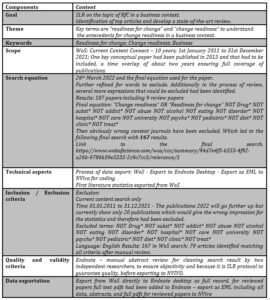
From the 187 publications, many had been published in journals publishing only substance abuse or addiction-related papers or papers with obviously no business-related content. The following journal titles had been excluded from the result: Addictive Behaviors, Journal of Substance Abuse Treatment, Journal of Addiction Medicine, Addiction or Alcoholism Clinical and Experimental Research Journal of Studies on Alcohol and Drugs, and Woman and Birth.
The final search delivered 167 articles including 9 reviewed articles. A manual abstract review was conducted by two independent researchers which resulted in the final list of 79 articles matching the set criteria.
Descriptive statistics
Descriptive analysis has been done for all article abstracts and with a higher level of detail for all reviewed articles on the full paper text. For the reviewed papers NVivo analyses based on full-text coding had been added. Results are summarized for article abstracts and reviewed full-text paper analyses. In Fig 1 the selection process is summarized.
Papers published per year show a growing tendency on a relatively low number in Fig 2. This tendency seems to prove right for 2022 as well as within the first two months of this year already 20 papers have been published.
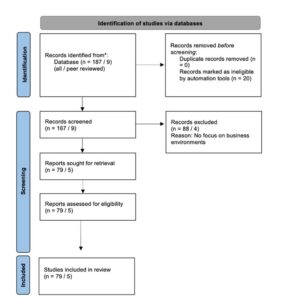
Fig 1. PRISMA selection process
Looking at the number of publications per year we see an increasing number of total publications which represents an increasing recognition of the importance of the topic (Fig 2).
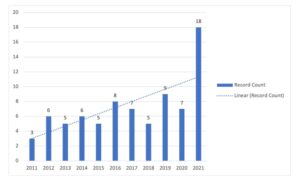 Fig 2. Publications per year
Fig 2. Publications per year
Regarding journals that publish in the RfC areas, from a total of 55 mentioned journals, only 8 published more than one paper on change readiness (Fig 3).
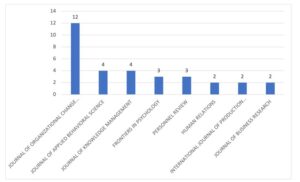
Fig 3. Top journals with 2 papers or more published
Of the total amount of 230 authors, two authors have published three papers, and 17 authors have published two, all the others just published one paper as shown in Fig 4.
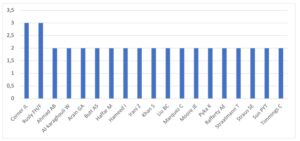
Fig 4. Top authors by quantity with more than 1 publication
Out of the 35 countries in which papers had been published only 18 countries had more than one paper published as we see in Fig 5.
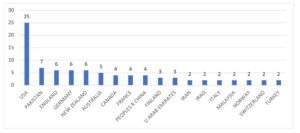
Fig 5. Countries of publication with more than 2 papers
The main areas of research according to WoS classification show a clear focus on business economics, followed by healthcare services, psychology, and behavioral sciences (Fig 6). The publications in other areas had all been checked for their match to fulfill the criteria of being business relevant.
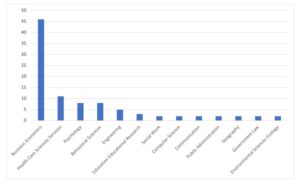
Fig 6. Research areas according to WoS classification
Using Voyant (Sinclair, 2022) to get the first data insights into the content of all 79 articles, an endnote XML file, including all abstracts, was exported and uploaded. A total of 35.053 words with 3002 unique words had been included, representing all abstracts. In Fig 7 the word cloud built with the top 75 words enables a visual representation of the words most used in the articles analyzed: the bigger and bolder the word appears, the more often it is mentioned in the abstracts. It shows change as the topmost cited word, followed by readiness and organizational. As organizational change readiness is a common term this had been expected. It is interesting to see that knowledge is coming up as well as management and study. The word study can be excluded as it refers to academic papers, on this first analysis the identified key areas related to RfC are organizational, management, and knowledge.
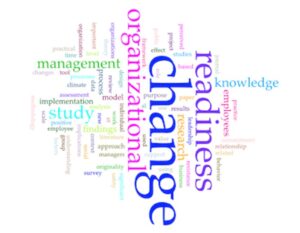
Fig 7. Word cloud of all abstracts
In Table 3 the top 20 most frequent words in the text corpus are listed, together with the total count. As can be seen the words change and readiness show most with 1178 and 556 counts, respectively. Less frequently used expressions allow a first reading of what are the most relevant contexts for change readiness publications in the business area. From this reading, we omitted some expressions that are the result of typical academic writing (e.g., study, research, findings).
Table 3: top 20 most frequent words
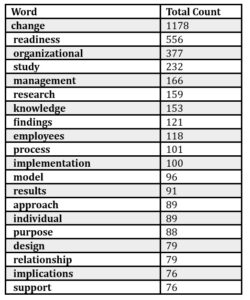
The spread of the top 10 words across the texts has been analyzed and shown in Fig 8. The words organizational and change show constant high mentions across the entire text, while expressions like knowledge, business, and management clearly show peaks in some texts. This allows a first insight into the research focus differences between the texts.

Fig 8. Voyant abstract analyses on relative frequency
As the next step, the relation of words has been analyzed and is shown in Fig 9. As expected, the strongest relation exists between the main search terms change and readiness. The figure shows further support that knowledge is directly related to readiness, readiness has links to individual and organization, and management is directly linked to organizational and change but not to individual.

Fig 9. Relation of top 10 words
The review articles identified are listed in Fig 10.
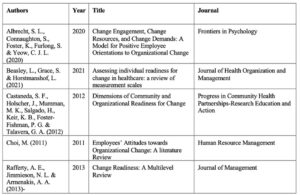
Fig 10. Review Articles
From the total amount of publications, only five had been review articles. These review articles will be presented and analyzed in more detail with the use of NVivo.
Aimed to increase RfC ability, Albrecht et al. (2020), introduced the model of change engagement as a useful and practical tool to explain employees’ engagement in change projects. The authors underline the importance of using positive motivators and supporting positive attitudes toward change in ongoing and complex work environments to build RfC (Albrecht et al., 2020).
Beasley et al. (2021) recently published a reviewed article that paves another significant perspective for further scientific research in RfC. Even though it has not yet gained too much attention, this work analyses all measurement scales for RfC for their target audience of healthcare professionals. Despite being really focused on a specific target audience, the complete overview of scales is a fast and valuable resource for new studies to be conducted.
Castaneda et al. (2012) research of ten years ago is not focused on a business environment but on a community level. Due to the very limited existing review articles available in this area of research and the fact that this work provides a good overview of possible measurement scales for RfC it has been decided to include it in this literature review as it is business relevant.
Choi’s (2011) literature review provides an overview of RfC-related concepts they define as constructs and concludes that the impacting factors on RfC are no personality traits but states that can change. The work of Choi (2011) reached 186 citations and was published in the Human Resource Management Journal, currently with an impact factor of 5.078.
Rafferty et al. (2013) created a very relevant literature review. Their article (Rafferty et al., 2013)is the most relevant publication (with 230 citations since 2013) and the one that showed the highest impact on the academic community.
Reviewed article analyses
The analyzed five documents with 51,251 total words and 7,237 unique word forms have the following text characteristics. The most frequent words in the entire text corpus are change (1799) and organizational (511) followed by readiness (431). In Fig 11 the relation to other relevant terms is visible and the combined term “Change* Readiness” has been added. In the column Trend the frequency spread over the length of the text corpus is represented. It shows that the keywords are used with different intensities and each work has its specific focus.

Fig 11. Key terms count and trend
The distinct word analyses summarized in Table 4 allow further insights into the relevant context in addition to the selection of keywords. The article from Beasley et al. (2021) which has a healthcare focus, frequently cites a paper from the author Di Fabio (2021) and refers to different scales used to measure RfC. For Castaneda et al. (2012), the research area of community change is obvious, prevention plays a big role in their paper which is referred to in the text as a manuscript. Albrecht et al. (2020) introduce a change engagement model and demand playing a significant role in their work. Choi (2011) bases argumentation on a publication from Meyer (1993) cited many times throughout their publication, in which organizational change and resource availability are nuclear topics in his work. Rafferty et al. (2013) focus on analyzing the antecedents of RfC, in which emotions play a significant role. Even so, this analysis cannot replace a proper reading, it provides a first idea of the context of the reviewed RfC papers.
Table 4: distinctive word analyses

In Fig 12 the keywords of the review publications are visualized and, once again, it shows that for all papers the keywords change and readiness are leading and therefore the papers clearly are relevant publications in this field of research. Building on the insights created in the word differentiation analyses allows an even deeper insight. While the works of Beasley et al. (2021) is the only one using the term scales, Rafferty et al. (2013) and Castaneda et al. (2012) show a higher relative frequency of the terms readiness and change readiness. All papers, except the one from Beasley et al. (2021), have a high relative frequency of the term organizational. Castaneda et al. (2012) usage of the term readiness nearly matches the use of the word change. The terms antecedents and resistance are less frequently used but clearly relevant terms in the work of Beasley et al. (2021), Choi (2011), and Rafferty et al. (2013).
 Fig 12. Key Words per reviewed paper
Fig 12. Key Words per reviewed paper
For the more detailed bubble frequency analysis, in Fig 13 alternative expressions had been added to the criteria to ensure that alternative forms of writing for organization could be identified, and business as a term had been added to give a reference point if the required business relevance is given. The words have been counted per publication and totals are listed at the right side of the graph, with the frequency across the text visualized. This analysis underlines the lower business relevance of Castaneda et al. (2012) as the term business is not mentioned at all; nevertheless, some reference to management provides a link with business relevance. The important relevance for RfC is given by Rafferty et al. (2013) and, with a lower frequency, by Beasley et al. (2021) and Albrecht et al. (2020).
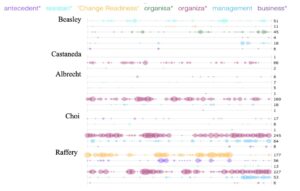
Fig 13. Bubble count analyses reviewed papers
In Fig 14 the correlation of terms had been used to visualize keywords within the reviewed articles. Readiness had been set as the center of visualization, Change Readiness had been added as a relevant term, and the terms et and al had been removed.
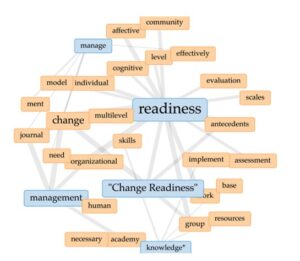 Fig 14. Correlation of relevant terms reviewed articles
Fig 14. Correlation of relevant terms reviewed articles
The related terms were automatically selected based on the highest correlation. The terms management and knowledge* had been added manually to show reference scales as they are recognized as influencing factors for RfC (Kotter, 1995b, Rusly et al., 2012).
In this analysis, a strong correlation between the word group to readiness and change can be seen. The word group again is related to the term knowledge*. Individual and organizational are again linked to readiness and show that individual as well as organizational readiness seem to be recognized by the authors.
Review articles coding
NVivo had been used to code all review articles based on a pre-defined codebook. The codebook had been planned based on the insights of the content analyses from section 3.2.1, following this coding logic:
- Geographical region / Business area
- Type of Paper: Empirical / Conceptual
- Identification of research question
- Methods used
- Identification of conceptual models/hypotheses or measurements
- Research contributions
- Change Readiness Insights
- Identified RfC antecedents
- RfC Frameworks/Concepts
- Change resistance factors
- Other relevant identified impact factors for RfC
The codebook had been extended during the first coding cycle and all papers were coded again with the final amount of 112 codes that had been used for all five articles coding. In total 5 review articles had been coded. In Table 5 the total amount of identified codes per paper can be found in column three, and the total amount of coding references is visible in column 2.
Table 5: coding overview reviewed papers
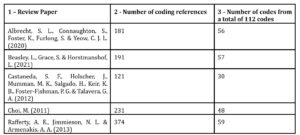
The fewest matching codes were found in Castaneda et al. (2012) with only 30 matched codes and 121 coding references, by far the most matching codes could be identified in Rafferty et al. (2013) with 59 matched codes and 374 coding references. The information in Column 2 can be an indicator of the relevance of the paper for the set research focus, while the number in column 3 shows that all papers had matching codes for a part of the total of the 112 codes used, providing an indicator that all papers have a different focus on different aspects of RfC.
Review papers analyses summary
In this section, the papers key characteristics and contributions have been summarized in Table 6.
Table 6: review papers analyses summary
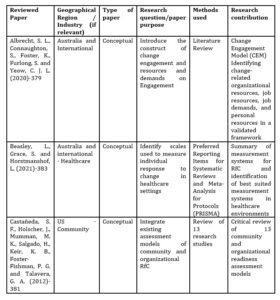
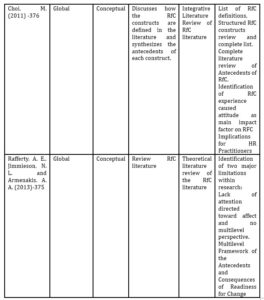
As a next step, the identified antecedents of RfC were sorted and put into a logical hierarchy. Fig 8 shows all coded antecedents and provides an overview of the complexity of RfC antecedents.

Fig 8. Antecedents identified and sorted
The following main categories were identified: Capability, Job, Meaning, Resources for Change, Experience, Leadership, Personality and Willingness. Figure 8 also shows the subcategories of analysis.
Final Considerations
In the last ten years, there has been a significant increase in conference proceedings and publications on RfC, yet only a limited amount of five business-relevant review articles have emerged. All five review articles share a general summary of the main concepts related to change readiness: CfC, Openness to change, Commitment to change, and Cynicism about change. Albrecht et al. (2020) introduce their own concept of the Change Engagement Model. There is also broad consensus regarding the antecedents of RfC, and although the focus of authors varies, most antecedents have been mentioned by more than one author.
An interesting finding from this analysis is that while there is substantial work on identifying and listing antecedents from earlier research, there has been limited collection of new data. There is a need for more research that focuses on one of the antecedents and provides deeper insight through a collection of new data.
Developing a concept that builds on specific antecedents and creates a concrete and applicable consulting framework for practical business use for generating practical business impact. Understanding the antecedents of RfC is important, but how to positively influence these antecedents remains an area for future research.
Albrecht et al. (2020) add their view on engagement and resources but base their new concept on earlier conceptual works and mention the limitation of missing validation of their concept.
The role of training, knowledge, and lifelong learning has been identified as a possible key element of building RfC, and it is suggested to identify the nature of this influence with more in-depth research. This will help business organizations especially because learning and development is already a key aspect of organizational development in modern companies. Garvin (1993) highlighted that businesses able to master the art of learning can gain a significant competitive advantage. This notion is further supported by the work of Akgün et al. (2003) who found a positive correlation between organizational learning and firm adaptability.
In conclusion, the readiness for change involves considering both individual and organizational factors. Effective management of RfC requires an integrated approach that encompasses leadership, communication, culture, and a deep understanding of the human aspects that can both facilitate and hinder the change process. By taking into account the various dimensions of suffering related to change and the antecedents of RfC, organizations can better prepare individuals for change and improve the likelihood of successful change implementation.
It is important to mention that this work is limited by its focus on a timeframe to represent 10 years of RfC research, more important work can be found in older publications that have been cited in the analyzed publications but had not been reviewed as part of this research. The selection of publications is also limited by the decision to exclude publications not relating to business environments and not specifically referring to RfC. The research is also limited to English language papers listed on the WoS within business.
Future research therefore needs to close all these gaps, validate the antecedents and their relevance for business environments and help to lift the academic state-of-the-art on RfC antecedents to practical solutions to impact one or more of the relevant antecedents in real-world business environments.
References
- Akgün, A. E., Lynn, G. and Byrne, J. (2003) ‘Organizational Learning: A Socio-Cognitive Framework’, Human Relations, 56, pp. 839-868.
- Albrecht, S. L., Connaughton, S., Foster, K., Furlong, S. and Yeow, C. J. L. (2020) ‘Change Engagement, Change Resources, and Change Demands: A Model for Positive Employee Orientations to Organizational Change’, Frontiers in Psychology, 11, pp. 31944-31944.
- Alnoor, A. M. R., Al-Abrrow, H., Abdullah, H. and Abbas, S. (2020) ‘The impact of self-efficacy on employees’ ability to accept new technology in an Iraqi university’, Global Business and Organizational Excellence, 39(2), pp. 41-50.
- Armenakis, A. a. and Harris, S. G. (2009) ‘Reflections: our Journey in Organizational Change Research and Practice’, Journal of Change Management, 9(2), pp. 127-142.
- Bartunek, J. M. and Woodman, R. W. (2014) ‘Beyond Lewin: Toward a Temporal Approximation of Organization Development and Change’, in Morgeson, F. P. (ed.) Annual Review of Organizational Psychology and Organizational Behavior, Vol 2. 157-182.
- Beasley, L., Grace, S. and Horstmanshof, L. (2020) ‘Responding and adapting to change: an allied health perspective’, Leadersh Health Serv (Bradf Engl), 33(4), pp. 339-349.
- Beasley, L., Grace, S. and Horstmanshof, L. (2021) ‘Assessing individual readiness for change in healthcare: a review of measurement scales’, Journal of Health Organization and Management, 35(8), pp. 1062-1079.
- Burnes, B. (2020) ‘The Origins of Lewin’s Three-Step Model of Change’, Journal of Applied Behavioral Science, 56(1), pp. 32-59.
- Cassel, E. J. (1982) ‘The nature of suffering and the goals of medicine’, N Engl J Med, 306(11), pp. 639-45.
- Castaneda, S. F., Holscher, J., Mumman, M. K., Salgado, H., Keir, K. B., Foster-Fishman, P. G. and Talavera, G. A. (2012) ‘Dimensions of Community and Organizational Readiness for Change’, Progress in Community Health Partnerships-Research Education and Action, 6(2), pp. 219-226.
- Choi, M. (2011) ‘Employees’ Attitudes towards Organizational Change: A Literature Review’, Human Resource Management, 50(4), pp. 479-500.
- Cummings, S., Bridgman, T. and Brown, K. G. (2016) ‘Unfreezing change as three steps: Rethinking Kurt Lewin’s legacy for change management’, Human Relations, 69(1), pp. 33-60.
- Di Fabio, A. (2021) ‘The psychology of sustainability and sustainable development: Transdisciplinary perspectives’, Journal of Psychology in Africa, 31(5), pp. 441-445.
- Garvin, D. A. (1993) ‘Building a learning organization’, Harvard Business Review, 71(4), pp. 78-91.
- Kotter, J. P. (1995a) ‘Leading Change – Why Transformation Efforts Fail ‘, Harvard Business Review, 73(2), pp. 59-67.
- Kotter, J. P. (1995b) ‘Lifetime Learning – The New Educational Imperative ‘, Futurist, 29(6), pp. 27-29.
- Kotter, J. P. (2001) ‘What leaders really do’, Harvard Business Review, 79(11), pp. 85-+.
- Kotter, J. P. (2012) ‘Change Management Accelerate!’, Harvard Business Review, 90(11), pp. 44-+.
- Kotter, J. P. (2013) ‘Leading Change When Disruption Is the Norm Response’, Harvard Business Review, 91(1-2), pp. 16-16.
- Kotter, J. P. and Schlesinger, L. A. (1979) ‘Choosing strategies for change’, Harvard Business Review, 57(2), pp. 106-114.
- Kotter, J. P. and Schlesinger, L. A. (2008) ‘Choosing strategies for change’, Harvard Business Review, 86(7-8), pp. 130-+.
- Lazarus, R. S. F., S. (1984) Stress, Appraisal, and Coping. New York: Springer Publishing Company.
- Lewin, K. (1945) ‘The Research Center for Group Dynamics at Massachusetts Institute of Technology’, Sociometry, 8(2), pp. 126-136.
- Li, K., Rollins, J. and Yan, E. (2018) ‘Web of Science use in published research and review papers 1997-2017: a selective, dynamic, cross-domain, content-based analysis’, Scientometrics, 115(1), pp. 1-20.
- Liu, H., Zhou, J. F., Liu, H. C. and Xin, B. N. (2021) ‘Is the uncertainty of gaining legitimacy from organizational change an antecedent of employees’ resistance to change?’, Chinese Management Studies, 15(4), pp. 769-784.
- Madsen, S. R., Miller, D. and John, C. R. (2005) ‘Readiness for organizational change: Do organizational commitment and social relationships in the workplace make a difference?’, Human Resource Development Quarterly, 16(2), pp. 213-234.
- Mengist, W., Soromessa, T. and Legese, G. (2020) ‘Method for conducting systematic literature review and meta-analysis for environmental science research’, MethodsX, 7, p. 100777.
- Meyer, J. P. A., Natalie J. Smith, Catherine A. (1993) ‘Commitment to organizations and occupations: Extension and test of a three-component conceptualization.’, Journal of Applied Psychology, 78, pp. 538–551.
- Moher, D., Liberati, A., Tetzlaff, J. and Altman, D. G. (2010) ‘Preferred reporting items for systematic reviews and meta-analyses: The PRISMA statement’, International Journal of Surgery, 8(5), pp. 336-341.
- Oreg, S., Vakola, M. and Armenakis, A. (2011) ‘Change Recipients’ Reactions to Organizational Change’, The Journal of Applied Behavioral Science, 47(4), pp. 461-524.
- Rafferty, A. E., Jimmieson, N. L. and Armenakis, A. A. (2013) ‘Change Readiness: A Multilevel Review’, Journal of Management, 39(1), pp. 110-135.
- Rafferty, A. E. and Minbashian, A. (2019) ‘Cognitive beliefs and positive emotions about change: Relationships with employee change readiness and change-supportive behaviors’, Human Relations, 72(10), pp. 1623-1650.
- Rusly, F. H., Corner, J. L. and Sun, P. (2012) ‘Positioning change readiness in knowledge management research’, Journal of Knowledge Management, 16(2), pp. 329-355.
- Saur-Amaral, I. (2015) ‘Wisdom-of-the-crowds to enhance innovation: state of the art’, Journal of Innovation Management, 3(3), pp. 71-89.
- Saur-Amaral, I., Soares, R. R. and Proença, J. F. (2018) ‘Business model innovation: towards a conceptual framework’, Tourism & Management Studies, 14(1), pp. 80-93.
- Senge, P. (1991) ‘The Learning Organization Made Plain’, Training & Development, 45(10), pp. 37-44.
- Senge, P. (1997) ‘Three cultures of management’, Sloan Management Review, 38(2), pp. 5-5.
- Senge, P. and Von Ameln, F. (2019) ‘We are not in control—embrace uncertainty and trust in what emerges. Peter Senge on the legacy and future of Change Management’, Interaktion. Organisation. Zeitschrift für Angewandte Organisationspsychologie (GIO), 50(2), pp. 123-127.
- Senge, P. M. (2003) ‘Taking personal change seriously: The impact of Organizational Learning on management practice’, Academy of Management Executive, 17(2), pp. 47-50.
- Senge, P. M., Senge, P. M., Doubleday and Company (1990) The Fifth Discipline: The Art and Practice of the Learning Organization. Doubleday/Currency.
- Senge, P. M. and Sterman, J. D. (1992) ‘System Thinking and Organizational Learning – Acting Locally and Thinking Globally in the Organization of the future’, European Journal of Operational Research, 59(1), pp. 137-150.
- Sinclair, D. G. R. S. (2022) Text analysis tool, Voyant Text Analysis Tool [Webtool]. Available at: https://voyant-tools.org/ (Accessed: 13th March).
- Studies, T., Saur-Amaral, I., Ferreira, P. and Conde, R. (2013) ‘Linking Past and Future Research in Tourism Management Through the Lens of Marketing and Consumption: A Systematic Literature Review’, Tourism & Management Studies, 9, pp. 35-40.
- Tranfield, D., Denyer, D. and Smart, P. (2003) ‘Towards a Methodology for Developing Evidence-Informed Management Knowledge by Means of Systematic Review’, British Journal of Management, 14, pp. 207-222.
























